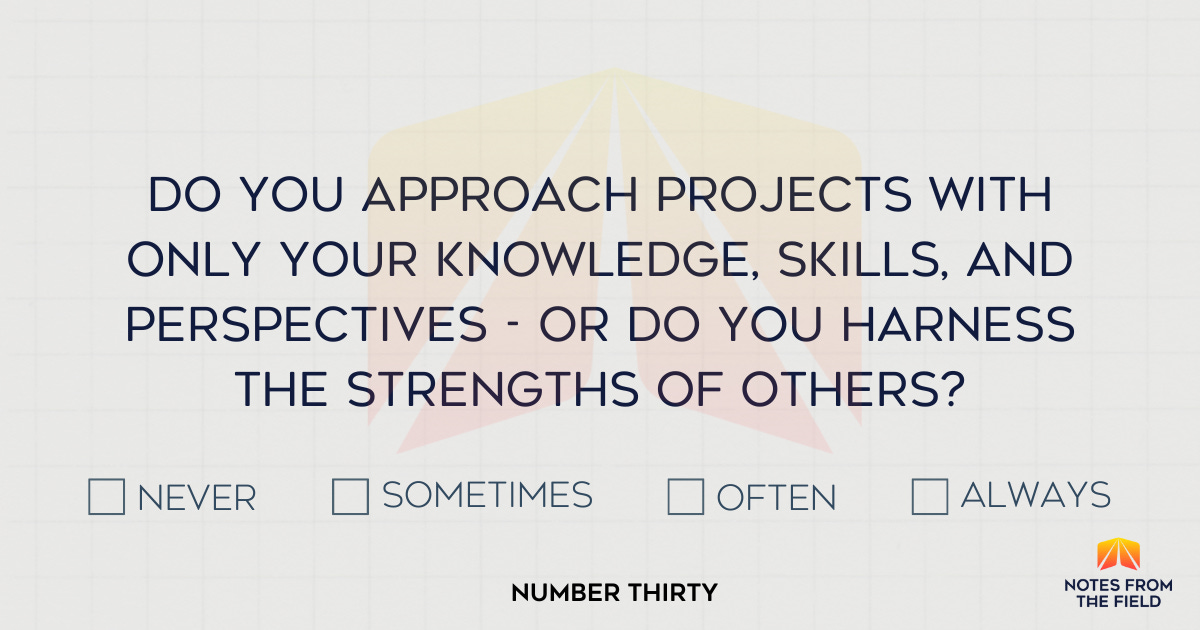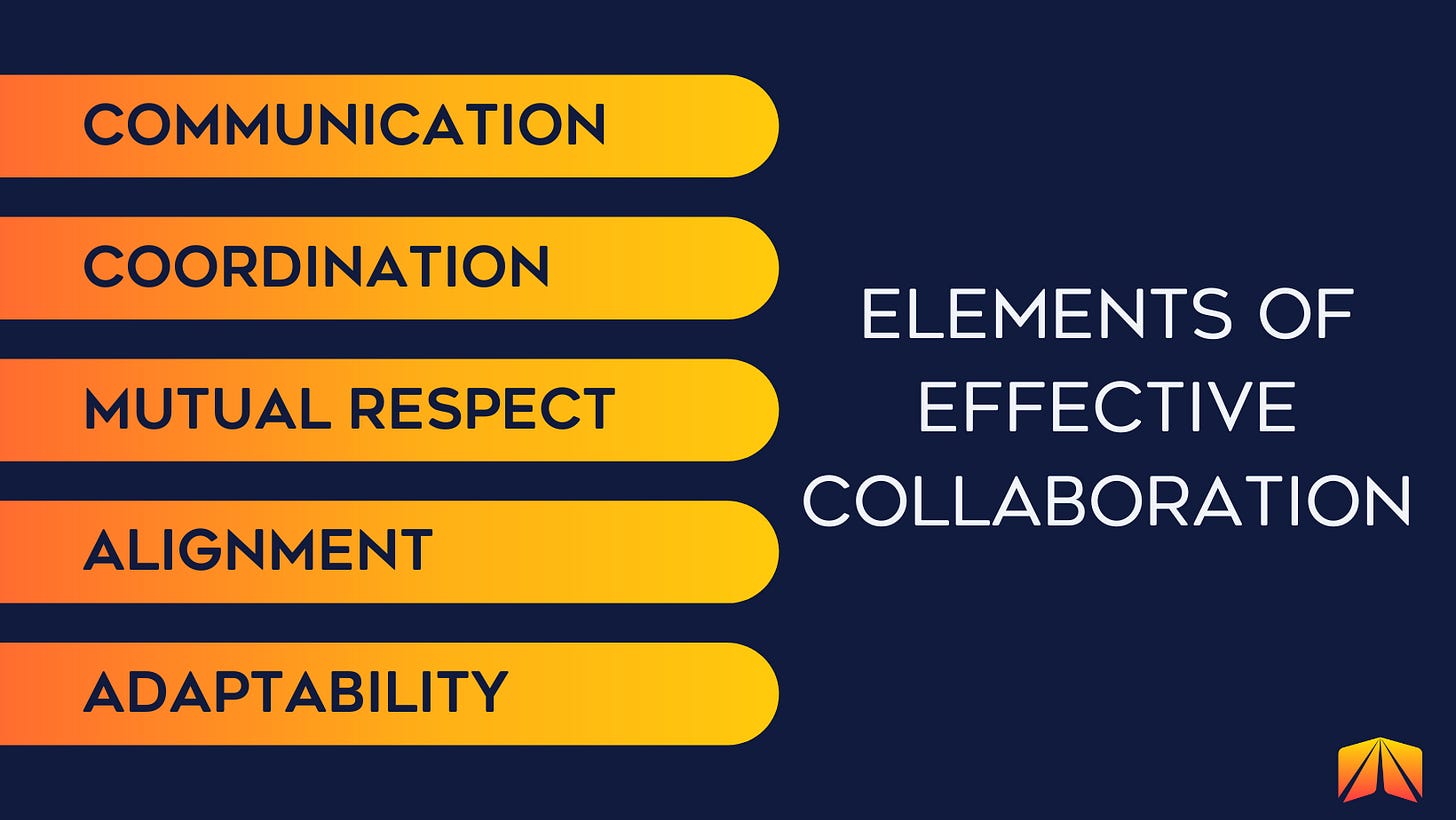On Soft Skills: Collaboration
For when you can't (or shouldn't) do it yourself.
Collaboration is a soft skill that enables a person to work effectively with others, fostering a sense of shared engagement and purpose. By harnessing diverse perspectives and leveraging individual strengths, successful collaboration can lead to valuable, visible contributions in your work.
What Is Collaboration
Collaboration is a soft skill that involves working effectively with others to achieve common goals. It encompasses various attributes and practices, including communication, coordination, mutual respect, and a willingness to share ideas and responsibilities. Collaboration is essential in both personal and professional contexts, as it can lead to increased productivity, improved problem-solving abilities, and stronger relationships.
Collaboration is not the same as simply working together or teamwork. It goes beyond just completing a task or project and involves active participation, open communication, and a shared understanding of goals and objectives.
Why Collaboration Is Important
Developing strong collaboration skills is more critical than ever. Simply put: the requirements and needs for any role or job are too demanding, complex, and ever-changing to be handled by a single individual's expertise. The world today (and tomorrow) requires an interdisciplinary approach, integrating and engaging multiple people to accomplish the things that need to get done.
In the workplace, collaboration creates pooling of resources, expertise, and perspectives to come up with innovative solutions and efficient tactical execution. Collaboration promotes a positive work environment where individuals have the opportunity to see their contributions as part of the larger, more valuable solution.
In personal and professional relationships, collaboration enables effective communication and conflict resolution, leading to stronger and healthier connections. It also promotes a sense of inclusivity and mutual respect, essential components for building strong relationships.
Benefits of Collaboration
Collaboration has numerous benefits for individuals and organizations. Some of the key advantages include:
Diversity: collaborating with others allows for the exchange of different perspectives and experiences. This diversity of thought can lead to more innovative solutions and a broader understanding of complex issues, leading to enhanced creativity and communication.
Problem Solving: when people collaborate, they bring their unique skills and expertise to the table. This enables them to tackle problems from different angles and come up with more comprehensive solutions.
Teamwork: collaboration requires effective communication and coordination, crucial components of successful teamwork. By working toward a common goal, individuals learn how to complement each other's strengths and support one another's weaknesses.
Productivity: by dividing tasks and responsibilities among team members, collaboration can help streamline processes and improve efficiency. This allows individuals to focus on their strengths and work together towards a shared objective.
Satisfaction: a collaborative work environment contributes to higher job & culture satisfaction People naturally feel more engaged and valued when they are part of a collaborative team.
Key Elements of Collaboration
Understanding the key elements of collaboration can help individuals and teams foster a more collaborative work environment. These elements include:
Communication
Effective collaboration requires clear and open communication. This includes active listening, sharing information openly, and providing constructive feedback.
Coordination
Collaboration involves coordinating tasks and responsibilities among team members. This ensures that efforts are aligned and resources are utilized efficiently.
Mutual Respect
Successful collaboration is built on mutual respect and trust among team members. This fosters a positive environment where individuals feel valued and are more willing to contribute.
Alignment
Collaboration focuses on achieving shared goals. Team members work together towards common objectives, ensuring that individual efforts contribute to the group’s success.
Adaptability
Effective collaborators are flexible and adaptable. They are willing to adjust their approaches and take on different roles as needed to support the team.
Mindset for Effective Collaboration
Collaboration is as much a skill as it is a mindset. Recognizing these mindsets - and shifting into a mode or environment to foster collaboration - is essential.
First: Think Collaborative-We, Not Competitive-I
Said another way: we can be successful in reaching our goals. This is not a zero-sum outcome; there is no winning or losing, no more-than or less-than when collaborating. Shift your mindset from being perceived as the best individual to being perceived as the best collaborator.
Be the common denominator for success across multiple projects or initiatives, not just one. Use "we", not "I" to express the shared goals, objectives, outcomes, and intent.
Second: A Little Extra Effort Pays Dividends
In a collaborative environment, we shift into a systems mindset and think about what will make the system work at full power and efficiency. While we are still human (and some inefficiency will continue to exist), a little extra effort will provide exponential benefit to the system.
If my emails are clear and succinct among many of my peers, we save the time, effort, and headaches of clarification (and our inbox from multiple back & forth emails.) If my meetings are structured with a clear agenda, necessary stakeholders, and positive outcome, we're able to reinvest that time and effort into more fruitful objectives and results.
Third: Assume Good Intent
Our brains are hardwired to feed on fear, doubts, and uncertainties. Our brains then create the story for an action to make sense. "Didn’t get invited to a meeting? I’m being deliberately shut out." "The unclear tone of that email? Must be a veiled insult." Actively shift your mindset to assume good intent: everyone wants the best outcome for the team and project with the easiest path to achieve it.
Replace the reaction to the meeting with "I'm not needed in that discussion, so I can focus on other, more important, things." Replace the reaction to the email with "The tone doesn't matter, but ensuring we're all on the same page is important." By shifting to assuming good intent, your focus remains on the shared objectives and goals - and not on things that may derail your individual path.
Improving Collaboration Skills
To enhance collaboration skills, individuals and teams should adopt a structured framework that focuses on specific actions and practices. Below are key strategies and examples:
Go Slow (through Planning), Then Fast (through Execution)
Having a shared vision and aligning on the goals & objectives of any project is crucial. Create goals to guide the collaboration process then ensure buy-in with everyone on the team at every update.
Example: In a project team, instead of saying, “We need to improve our marketing,” set a goal like “Increase social media engagement by 30% in the next quarter.” Then, with your team, break down the work into actionable steps and designate who is responsible or accountable for the work as well as who should be consulted or informed about progress, challenges, and opportunities. This alignment ensures all team members are working toward the same objectives and outcomes - and ensures everyone knows who is doing what work when and why. Buy-in is a slow but repeatable process, but it ensures success with everyone involved at every step of a complex or complicated project.
Develop Active Listening Skills
Fostering an environment where everyone feels heard can significantly enhance collaboration. Practice active listening techniques, such as paraphrasing what others have said.
Example: During meetings, actively summarize key points raised by team members before responding, ensuring everyone feels heard and understood. Once alignment is established, then add your comments, thoughts, ideas, questions, or concerns.
Leverage Technology Tools
Utilize collaboration tools like Slack, Asana, or Trello to facilitate ongoing communication and project tracking.
Example: Set up a shared project management board for project tasks, allowing team members to update their progress and comment on each other’s work in real-time.
Conduct Regular Check-Ins
Schedule quick recurring meetings or huddles to assess progress, address concerns, and realign goals.
Example: Implement weekly 10 minute stand-up meetings where all team members share updates. Keep these meetings short, structured, and simple. Anything that can't be solved in under 45 seconds should be addressed outside of these meetings with only the people necessary to the conversation. Any outcomes or impacts from outside meetings should be communicated either in writing to the rest of the team or as an update at the regular check-in, depending on the nature of the outcome or impacts.
Encourage Feedback and Constructive Criticism
Do your part to participate and engage in a culture where feedback is welcomed and seen as a growth opportunity. Encourage team members to provide input on both group and individual performance.
Example: Organize regular retrospectives after project completions to review what worked well and identify areas for improvement.
Foster Social Connections
Building relationships outside of work tasks enhances collaboration. People who like spending time with each other work more collaboratively together. Engage in team-building activities to bolster camaraderie.
Example: Plan informal team outings or virtual coffee chats to strengthen personal connections among team members. People who know one another outside of the work develop more respect, trust, and belonging within the larger team, making collaboration easier and faster.
By integrating these strategies into everyday practices, teams can cultivate a collaborative environment that thrives on effective communication, mutual respect, and shared objectives.
Additional Resources on Collboration
Read
Collaboration: How Leaders Avoid the Traps, Create Unity, and Reap Big Results by Morten T. Hansen
This book digs into how to effectively collaborate and overcome common pitfalls in teamwork
Team of Teams: New Rules of Engagement for a Complex World by General Stanley McChrystal
Explore how to foster collaboration in complex environments and create adaptable teams
The Culture Code: The Secrets of Highly Successful Groups by Daniel Coyle
Learn about the principles that make successful groups and teams thrive
Learn
Teamwork Skills: Communicating Effectively in Groups by University of Colorado Boulder
Focuses on communication strategies for effective collaboration.
Teamwork & Collaboration by Rochester Institute of Technology
Teaches the fundamentals of collaborative problem-solving.
Listen
Conversations about Collaboration by Phil Simon
Phil interviews interesting, progressive, and accomplished folks with strong views on how to get people to work together effectively.
Stop, Collaborate, and Listen by Baily Hancock
Through conversations with authors, creatives, entrepreneurs, social impact leaders, and more, Baily Hancock explores how concepts like connection, creativity, innovation, social impact, and amplification both support and are benefitted by collaboration.




